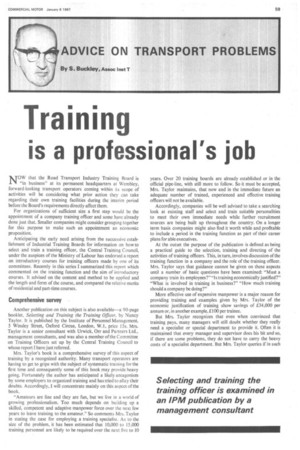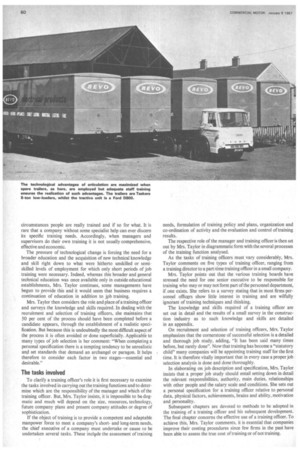Training
Page 61

Page 62

If you've noticed an error in this article please click here to report it so we can fix it.
is a professional's job
NOW that the Road Transport Industry Training Board is "in business" at its permanent headquarters at Wembley, forward-looking transport operators coming within its scope of activities will be considering what prior action they can take regarding their own training facilities during the interim period before the Board's requirements directly affect them.
For organizations of sufficient size a first step would be the appointment of a company training officer and some have already done just that. Smaller companies might consider grouping together for this purpose to make such an appointment an economic proposition.
Anticipating the early need arising from the successive establishment of Industrial Training Boards for information on how to select and train a training officer, the Central Training Council, under the auspices of the Ministry of Labour has endorsed a report on introductory courses for training officers made by one of its committees. Recently in this series I summarized this report which commented on the training function and the aim of introductory courses. It advised on the content and method to be applied and the length and form of the course, and compared the relative merits of residential and part-time courses.
Comprehensive survey •
Another publication on this subject is also available—a 90-page booklet, Selecting and Training the Training Officer, by Nancy Taylor. It is published by the Institute of Personnel Management, 5 Winsley Street, Oxford Circus, London, W.1, price 15s. Mrs. Taylor is a senior consultant with Urwick, Orr and Partners Ltd., management consultants, and was also a member of the Committee on Training Officers set up by the Central Training Council to whose report [have just referred.
Mrs. Taylor's book is a comprehensive survey of this aspect of training by a recognized authority. Many transport operators are having to get to grips with the subject of systematic training for the first time and consequently some of this book may provide heavy going. Fortunately the author has anticipated a likely antagonism by some employers to organized training and has tried to allay their doubts. Accordingly, I will concentrate mainly on this aspect of the book.
"Amateurs are fine and they are fun, but we live in a world of growing professionalism. Too much depends on building up a skilled, competent and adaptive manpower force over the next few years to leave training to the amateur." So comments Mrs. Taylor in stating the case for employing a training specialist. As to the size of the problem, it has been estimated that 10,000 to 15,000 training personnel are likely to be required over the next five to 10 years. Over 20 training boards are already established or in the official pipe-line, with still more to follow. So it must be accepted, Mrs. Taylor maintains, that now and in the immediate future an adequate number of trained, experienced and effective training officers will not be available.
Accordingly, companies will be well advised to take a searching look at existing staff and select and train suitable personalities to meet their own immediate needs while further recruitment sources are being built up throughout the country. On a longer term basis companies might also find it worth while and profitable to include a period in the training function as part of their career plans for able executives.
At the outset the purpose of the publication is defined as being a practical guide to the selection, training and directing of the activities of training officers. This, in turn, involves discussion of the training function in a company and the role of the training officer. Mrs. Taylor says that guidance cannot be given on these aspects until a number of basic questions have been examined: "Must a company train its employees?" "Is training economically justified?" "What is involved in training in business?" "How much training should a company be doing?"
More effective use of expensive manpower is a major reason for providing training and examples given by Mrs. Taylor of the economic justification of training show savings of £34,000 per annum or, in another example, £100 per trainee.
But Mrs. Taylor recognizes that even when convinced that training pays, many managers will still doubt whether they really need a specialist or special department to provide it. Often it is maintained that every manager and supervisor does his bit and so, if there are some problems, they do not have to carry the heavy costs of a specialist department. But Mrs. Taylor queries if in such circumstances people are really trained and if so for what. It is rare that a company without some specialist help can ever discern its specific training needs. Accordingly, when managers and supervisors do their own training it is not usually comprehensive, effective and economic.
The pressure of technological change is forcing the need for a broader education and the acquisition of new technical knowledge and skill right down to what were hitherto unskilled or semiskilled levels of employment for which only short periods of job training were necessary. Indeed, whereas this broader and general technical education was once available only in outside educational establishments, Mrs. Taylor continues, some managements have begun to provide this and it would seem that business requires a continuation of education in addition to jpb training.
Mrs. Taylor then considers the role and place of a training officer and surveys the knowledge and skills required. In dealing with the recruitment and selection of training officers, she maintains that 50 per cent of the process should have been completed before a candidate appears, through the establishment of a realistic specification. But because this is undoubtedly the most difficult aspect of the process it is often avoided or done superficially. Applicable to many types of job selection is her comment: "When completing a personal specification there is a tempting tendency to be unrealistic and set standards that demand an archangel or paragon. It helps therefore to consider each factor in two stages—essential and desirable."
The tasks involved
To clarify a training officer's role it is first necessary to examine the tasks involved in carrying out the training functions and to determine which are the responsibility of the manager and which of the training officer. But, Mrs. Taylor insists, it is impossible to be-dogmatic and much will depend on the size, resources, technology, future company plans and present company attitudes or degree of sophistication.
If the object of training is to provide a competent and adaptable manpower force to meet a company's shortand long-term needs, the chief executive of a company must undertake or cause to be undertaken several tasks. These inclycle the assessment of training needs, formulation of training policy and plans, organization and co-ordination of activity and the evaluation and control of training results.
The respective role of the manager and training officer is then set out by Mrs. Taylor in diagrammatic form with the several processes of the training function analysed.
As the tasks of training officers must vary considerably, Mrs. Taylor comments on five types of training officer, ranging from a training director to a part-time training officer in a small company.
Mrs. Taylor points out that the various training boards have stressed the need for one senior executive to be responsible for training who may or may not form part of the personnel department, if one exists. She refers to a survey stating that in most firms personnel officers show little interest in training and are wilfully ignorant of training techniques and thinking.
The knowledge and skills required of a training officer are set out in detail and the results of a small survey in the construction industry as to such knowledge and skills are detailed in an appendix.
On recruitment and selection of training officers, Mrs. Taylor emphasizes that the cornerstone of successful selection is a detailed and thorough job study, adding, "It has been said many times before, but rarely done". Now that training has become a "statutory child" many companies will be appointing training staff for the first time. It is therefore vitally important that in every case a proper job selection analysis is done and done thoroughly.
In elaborating on job description and specification, Mrs. Taylor insists that a proper job study should entail setting down in detail the relevant responsibilities, authority, main duties, relationships with other people and the salary scale and conditions. She sets out a personal specification for a training officer relative to personal data, physical factors, achievements, brains and ability, motivation and personality.
Subsequent chapters are devoted to methods to be adopted in the training of a training officer and his subsequent development. The final chapter concerns the effective use of a training officer. To achieve this, Mrs. Taylor comments, it is essential that companies improve their costing procedures since few firms in the past have been able to assess the true cost of training or of not training.












































































































